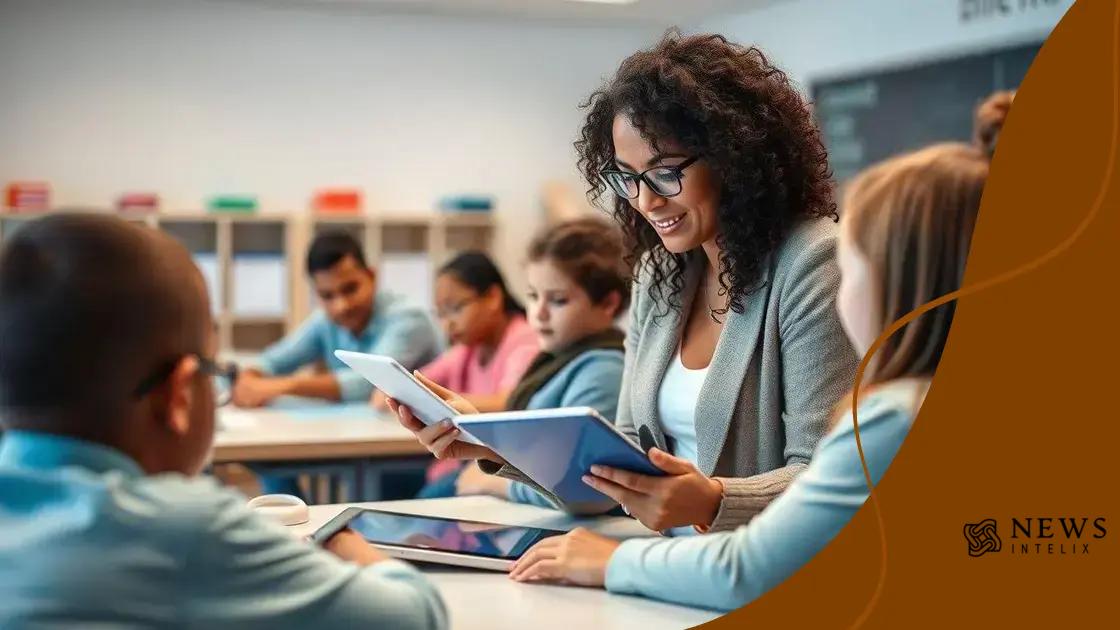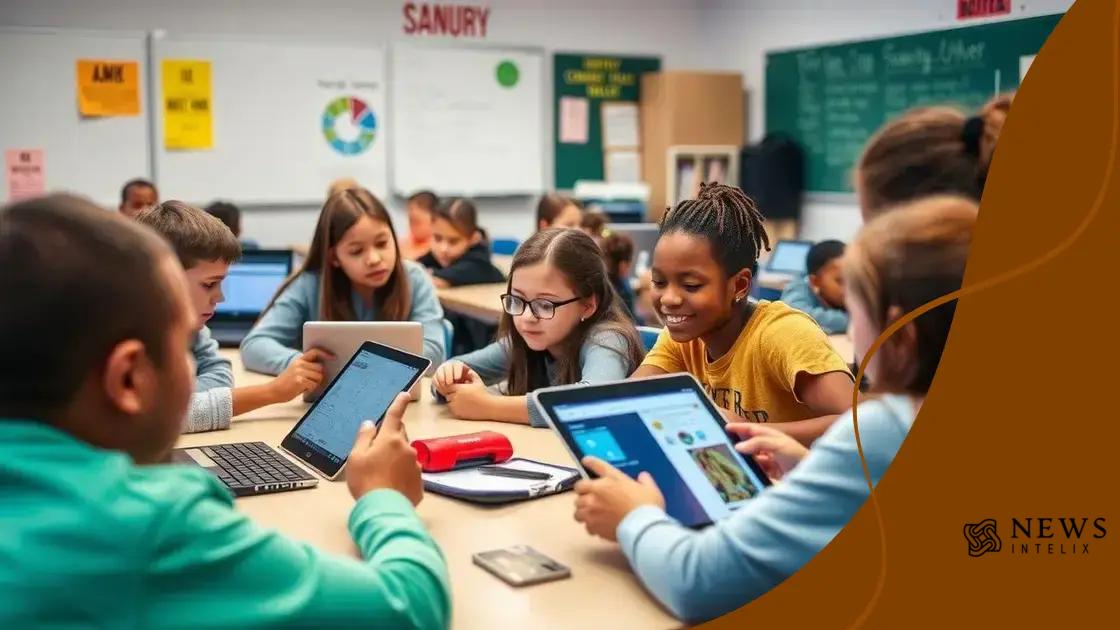Teachers get tech training for modern classrooms

Teachers get tech training to enhance their skills, improve student engagement, and effectively integrate technology into lessons, addressing challenges such as limited resources and professional development gaps.
Teachers get tech training to equip themselves for the evolving educational landscape. With technology becoming integral in classrooms, it’s essential to explore how these skills impact teaching practices and student outcomes. Ready to dive into the details?
the importance of tech skills for teachers
In today’s fast-paced educational landscape, the importance of tech skills for teachers cannot be overstated. As classrooms evolve, educators need to adapt to new technologies that enhance learning experiences. Equipped with the right tech skills, teachers can engage students more effectively and foster a dynamic learning environment.
The benefits of tech skills
Developing strong tech skills offers numerous advantages for teachers. These skills help in streamlining lesson planning, improving classroom management, and increasing student engagement. Being comfortable with technology allows teachers to access a wealth of resources and tools designed to enhance the learning process.
- Boosts student participation
- Enables personalized learning
- Facilitates collaboration among students
- Makes learning more interactive
Moreover, tech-savvy teachers can integrate various educational tools, like digital platforms and apps, into their teaching. This not only supports diverse learning styles but also prepares students for a tech-driven world. When educators embrace technology, they create an engaging curriculum that sparks curiosity and enthusiasm.
Increasing adaptability
Adapting to new technologies can seem daunting, but it’s essential for teachers. Learning how to utilize these tools effectively means being open to ongoing professional development. Workshops, online courses, and collaborative learning can provide teachers the support they need to build their confidence with technology.
As the educational landscape continues to change, teachers must embrace tech skills to remain relevant. The ability to adapt and grow with changing technologies directly impacts students’ success. By becoming proficient in tech skills, teachers not only enhance their teaching effectiveness but also model lifelong learning for their students.
top tech training programs available
When it comes to enhancing their skills, teachers have several options for top tech training programs available. These programs are designed to provide educators with the tools they need to integrate technology into their teaching effectively. With many choices out there, it’s essential to find the right program that suits individual needs.
Online Learning Platforms
Many online platforms offer specialized training for educators. These courses allow teachers to learn at their own pace from the comfort of their homes. Some popular platforms include:
- Coursera: Offers courses from top universities on educational technology.
- edX: Features professional development programs tailored for teachers.
- Udemy: Provides a variety of courses focusing on specific tech tools.
Each of these platforms provides flexible learning options. Through video lessons and interactive exercises, teachers can build their tech skills while exploring new teaching methods.
Workshops and Conferences
For teachers who prefer hands-on experience, workshops and conferences are excellent choices. Attending these events fosters collaboration and networking with other educators. Participants get to:
- Learn from experts in tech education.
- Engage in practical sessions that enhance learning.
- Discover the latest trends in educational technology.
Such interactive environments ensure that teachers are not just learning theory but are also practicing new strategies. This direct engagement often results in better retention of information.
Another option available for teachers is local district-sponsored training. Many school districts offer sessions tailored to the specific needs of their educators. These programs often focus on school-wide technologies and platforms, ensuring that all teachers are on the same page.
how tech training improves student engagement

The way tech training improves student engagement is becoming clearer in today’s classrooms. Educators equipped with the latest technology skills can create more interactive and responsive learning environments. When teachers are confident in using technology, they are more likely to inspire students to participate actively.
Interactive Learning Tools
One major benefit of tech training is the ability to utilize interactive learning tools. These tools can transform traditional lessons into engaging experiences. For instance, educators can use:
- Interactive presentations: Using platforms like Pear Deck or Nearpod allows students to respond in real-time.
- Gamification: Incorporating game elements in lessons can make learning fun and motivating.
- Virtual reality: Immersive experiences can help students explore concepts in a hands-on way.
These elements foster a sense of involvement, allowing students to take charge of their learning. The more engaged they are, the better their retention of information.
Encouraging Collaboration
Tech training also helps teachers facilitate collaboration among students. Educators who know how to use collaborative tools can create group projects that connect learners. With technology, students can work together on platforms like Google Docs or Microsoft Teams. This collaborative atmosphere promotes teamwork and communication skills. As students share ideas and feedback, they become more invested in their group’s success.
When teachers implement tech effectively, it encourages creative problem-solving. Students feel empowered to share their thoughts and perspectives, leading to enriched classroom discussions. As a result, learning becomes a shared journey instead of a solitary endeavor.
challenges teachers face in tech adoption
Despite the many benefits of technology in the classroom, there are significant challenges teachers face in tech adoption. These obstacles can hinder the integration of new tools and methods, making it harder for educators to enhance their teaching practices. Understanding these challenges is essential for overcoming them.
Limited Access to Resources
One major challenge is the lack of access to necessary technology. Many schools may not have enough devices or high-speed internet for all students. This limitation can lead to:
- Frustration among teachers who want to integrate technology but lack the tools.
- Unequal learning opportunities for students who do not have access to technology outside school.
- Overcrowded classrooms where sharing devices is not feasible for effective learning.
Without sufficient resources, teachers may struggle to implement tech-driven lessons, leading to disengagement among students.
Professional Development Gaps
Another issue is the lack of adequate professional development. While many educators are eager to learn, they may not receive the necessary training on how to use technology effectively. Many training sessions do not focus on practical applications or are not tailored to their specific needs. This gap can result in:
- Increased anxiety: Teachers may feel overwhelmed by the speed of technological advancement.
- Resistance to change: Educators might hesitate to adopt new tools if they do not feel confident.
- Inconsistent tech usage: Without proper training, some teachers may opt to stick with traditional methods.
As a result, the potential of technology to enhance learning experiences can be underutilized.
Furthermore, integrating technology into lessons requires time and effort. Many teachers are already stretched thin with their existing workloads. Finding the time to learn new tools and incorporate them into their curriculum can be challenging. This adds another layer of complexity to tech adoption in the classroom.
tips for effective tech integration in lessons
Integrating technology into lessons can greatly enhance the learning experience. Here are some tips for effective tech integration in lessons. By following these strategies, teachers can create engaging and interactive classrooms.
Start Simple
Begin with simple tools that everyone can use. Choose applications that are user-friendly and require minimal setup. This allows teachers to focus on what matters most: student learning. Consider:
- Using educational apps: Start with apps already familiar to students, like Kahoot! or Quizlet.
- Incorporating multimedia: Use videos or podcasts to explain complex topics.
- Utilizing class blogs: Encourage students to share their thoughts and engage in discussions.
Keeping things simple helps build confidence for both teachers and students.
Align Technology with Learning Goals
It’s essential to ensure that the technology used aligns with the learning objectives. Determine what skills or content areas you want to enhance. Ask yourself:
- How will this tool benefit my students?
- Does it facilitate deeper understanding?
- Can I assess students’ learning effectively with this technology?
When technology is linked to learning goals, it becomes a powerful tool for success.
Additionally, encourage students to take ownership of their learning. Allow them to explore technologies that interest them or provide options for projects. This independence can lead to increased motivation and investment in their learning process.
Provide Training and Support
Offering training for both teachers and students is key to successful integration. Regular professional development sessions enable teachers to stay updated with new tools and best practices. Students, too, benefit from guidance on how to use technology effectively. This can be achieved through:
- Peer mentoring: Pair tech-savvy students with those who need assistance.
- Workshops: Organize hands-on training sessions for educators.
- Online resources: Create a shared resource bank for teachers to access tutorials and guides.
By fostering a supportive environment, teachers can alleviate anxiety around technology, paving the way for more innovative lessons.
FAQ – Frequently Asked Questions About Tech Integration in Education
What are the benefits of integrating technology into lessons?
Integrating technology enhances student engagement, supports collaboration, and fosters a more interactive and personalized learning experience.
How can teachers start using technology in their classrooms?
Teachers can start with simple and user-friendly tools, focus on aligning technology with learning goals, and offer opportunities for training and professional development.
What challenges do educators face with tech adoption?
Challenges include limited access to resources, gaps in professional development, and the need for ongoing support to effectively integrate technology.
How can collaboration be encouraged among students using technology?
Teachers can use collaborative tools such as Google Docs or shared platforms to promote teamwork and communication in group projects.
